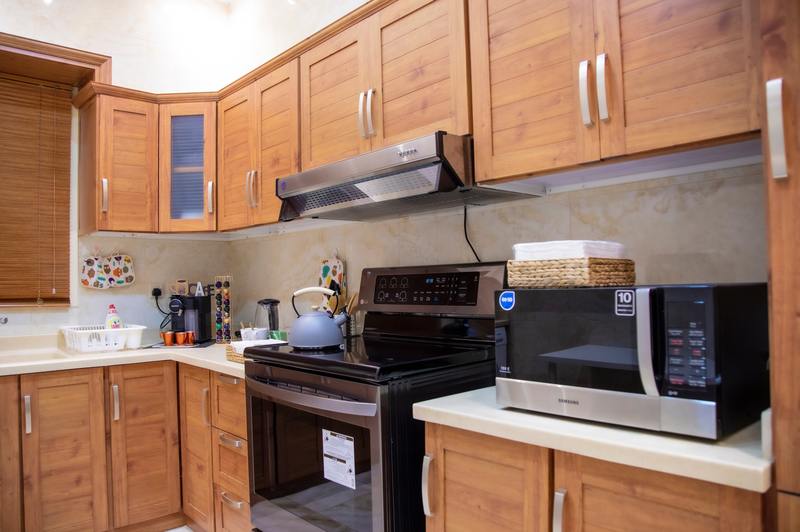A tip on how to prevent mildew in cabinets is to keep them dry. If you want to know more, proceed until the end of the article.

What Is Mildew?
There are two classifications of mildew, both of which are more commonly seen on plants. They are downy and powdery mildew.
Both types of mildews are products of different fungal pathogens. They are even identified differently on the plants they damage.
Powdery mildew looks harmless and is seen on the topside of plants’ leaves. On the other hand, the downy mildew is more challenging to identify as they are not seen in more obvious places like powdery mildew.
Learn more about these two types of mildew by reading this article on what causes downy mildew. Although, if you’re interested in mildew removal, here’s an article on how to get rid of powdery mildew on cannabis plants may help.
Mildew is often light yellow or white, contrasting mold’s dark colors (green, blue, and black). However, its light color leads to the misconception of mildew being the early stage of mold when it is not.
Mildew is a different fungi type, but it does invite mold to the environments it grows on after some time.
How Does Mildew Develop On Cabinets?
Cabinets are a staple in every household. They can be seen in bathrooms, bedrooms, and kitchens.
They also contain numerous things, making them more vulnerable to liquid spills and food particles, therefore inviting fungus growth. For cabinets located in bathrooms and kitchens, they may have to deal with moisture in the air.
This can lead to water damage. We’re sure you know how dangerous water can be to your house structures.
It can weaken the cabinets’ integrity and invite fungi, luring pests. Moreover, mildew rapidly spreads from one surface to another.
Mildew contamination can lead to multiple problems because of the contents inside the cabinets. For example, it may affect the food you store there.
Eating mildew-contaminated food may result in stomach aches and other types of illnesses.
If your bathroom cabinets get contaminated, your personal hygiene may be affected. You may also experience skin allergies and the like.
Water damage is not the only thing that causes mildew. Food debris can also increase fungi, especially since mildew loves organic matter.
If you leave mildew unattended, you will face another serious issue: mold. This is more damaging to your cabinets as it breaks down the wood, leading to wood rot.
What Are The Signs Of Mildew Growth?
One tell-tale sign of mildew growth on cabinets is the musty smell. The odor is due to microbial volatile organic compounds (MVOCs).
Exposure to such also causes eye and upper respiratory tract irritation, hence why people with mildew-contaminated homes often have allergic reactions.
Another way to detect mildew is seeing the white powdery or downy growth on your cabinets. You shouldn’t touch the mildew with your bare hands even if you see such buildup.
We do not recommend sniffing your cabinets for the musty smell, either. Mildew exposure may have milder effects than mold, but they’re still dangerous, especially to vulnerable people.
Another way to tell if your cabinet has mildew or mold is water stains. After water damage, it only takes a day or two before fungi start growing.
If the water damage is left unattended, you’re giving the fungi free reign to ruin your cabinets and adjacent structures.
Tips In Preventing Mildew In Cabinets
Tip #1. Avoid water damage
Water damage is your biggest enemy as a homeowner. It causes damage to your belongings and brings in fungi, which further destroys your home structures.
Thus, it is crucial to prevent water damage to protect your cabinets from mold or mildew contamination.
One way to do this is to inspect your piping system, check it for damages, or if the pipes are correctly installed. You can simply remove spills as soon as they happen.
Liquid spills may be unavoidable, but they’re not entirely impossible to amend. You have to ensure that you dry your cabinets properly after cleaning up.
Tip #2. Do regular cleaning
In line with avoiding water damage is doing regular cleaning. Having a food source, whether it’s in the form of organic debris or dirt, could lead to mildew growth.
Since we want to prevent mildew contamination, we should promptly maintain our cabinets and rid them of dirt that could invite fungi.
Tip #3. Control the humidity levels
After preventing water damage and doing regular cleaning, you should also encourage airflow, especially in the bathroom. Moisture-rich environments coupled with a lack of proper ventilation lead to mildew growth.
Wipe down your bathroom and open your windows to keep the air fresh in your room. It would also do you good to take a whiff of outside air.
Tip #4. Dry the contents
Lastly, before placing stuff inside your cabinets, ensure that they are dry. Inspect containers for possible cracks as well.
Conclusion
You’ve learned more than how to prevent mildew in cabinets, how it grows, and how to detect them.
Mildew may not give you as much trouble as mold. However, it can lead to mold growth, so you should take it seriously before it leads to something more severe.
